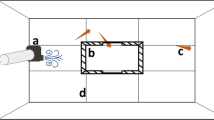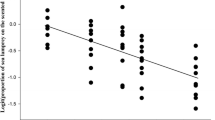Abstract
A variety of fishes possess damage-released chemical alarm cues, which play a critical role in the detection and avoidance of potential predation threats. Recently, we have demonstrated that the ability of fathead minnows (Pimephales promelas) and finescale dace (Phoxinus neogaeus) to detect and respond to conspecific alarm cues is significantly reduced under weakly acidic conditions (pH 6.0). Rainbow trout (Oncorhynchus mykiss) and brook charr (Salvelinus fontinalis) possess an analogous alarm cue system. However, it is unknown if the trout alarm cue system is likewise affected by relatively small changes in pH. In addition, previous studies have not verified this phenomenon under natural conditions. We conducted laboratory and field trials to examine the potential effects of acute exposure to weakly acidic (pH 6.0) conditions on the detection and response of conspecific alarm cues by juvenile trout. Our laboratory results demonstrate that while juvenile rainbow trout exhibit significant increases in antipredator behaviour under normal pH conditions (pH 7.0–7.2), they do not respond to the presence of conspecific chemical alarm cues (i.e. response is not different from controls) under weakly acidic conditions. Similarly, a wild strain of brook charr in their natural streams near Sudbury, Ontario, failed to detect conspecific alarm cues in a weakly acidic stream (mean pH 6.11) while they responded to these cues in a neutral stream (mean pH of 6.88). This is the first demonstration that relatively small changes in ambient pH can influence alarm responses under natural conditions. These data suggest significant, sub-lethal effects of acid precipitation on natural waterways.


Similar content being viewed by others

References
Åtland A (1998) Behavioural responses of brown trout, Salmo trutta, juveniles in concentration gradients of pH and Al—a laboratory study. Environ Biol Fish 53:331–345
Barry KL, Grout AG, Levings CD, Nidle BH, Piercy E (2000) Impact of acid mine drainage on juvenile salmonids in an estuary near Britannia Beach in Howe Sound, British Columbia. Can J Fish Aquat Sci 57:2032–2043
Brown C, Laland K (2001) Social learning and life skills training for hatchery reared fish. J Fish Biol 59:471–493
Brown GE (2003) Learning about danger: chemical alarm cues and local risk assessment in prey fishes. Fish Fish 4:227–234
Brown GE, Magnavacca G (2003) Predator inspection behaviour in a characin fish: an interaction between chemical and visual information? Ethology 109:739–750
Brown GE, Smith RJF (1997) Conspecific skin extracts elicit anti-predator responses in juvenile rainbow trout (Oncorhynchus mykiss). Can J Zool 75 1916–1922
Brown GE, Smith RJF (1998) Acquired predator recognition in juvenile rainbow trout (Oncorhynchus mykiss): conditioning hatchery reared fish to recognize chemical cues of a predator. Can J Fish Aquat Sci 55:611–617
Brown GE, Adrian JC Jr, Smyth E, Leet H, Brennan S (2000) Ostariophysan alarm pheromones: Laboratory and field tests of the functional significance of nitrogen oxides. J Chem Ecol 26:139–154
Brown GE, Adrian JC Jr, Kaufman IH, Erickson JL, Gershaneck D (2001) Responses to nitrogen-oxides by Characiforme fishes suggest evolutionary conservation in Ostariophysan alarm pheromones. In: Marchlewska-Koj A, Lepri JJ, Müller-Schwarze D (eds) Chemical signals in vertebrates, vol 9. Plenum, New York, pp 305–312
Brown GE, Adrian JC Jr, Lewis MG, Tower JM (2002) The effects of reduced pH on chemical alarm signaling in Ostariophysan fishes. Can J Fish Aquat Sci 59:1331–1338
Chivers DP, Smith RJF (1998) Chemical alarm signaling in aquatic predator-prey systems: A review and prospectus. Ecoscience 5:338–352
Chivers DP, Mirza RS, Johnston JG (2002) Learned recognition of heterospecific alarm cues enhances survival during encounters with predators. Behaviour 139:929–938
Donnelly WA, Whoriskey FG Jr (1993) Transplantation of Atlantic salmon (Salmo salar) and crypsis breakdown. Can Spec Publ Fish Aquat Sci 118:25–34
Environment Canada (1997) Canadian acid rain assessment, vol 3: the effects on Canada’s lakes, rivers and wetlands. Ministry of Environment, Ottawa
Gazdewich KJ, Chivers GP (2002) Acquired predator recognition by fathead minnows: influence of habitat characteristics on survival. J Chem Ecol 20:439–445
Grant JWA, Kramer DL (1990) Territory size as a predictor of the upper limit to population density of juvenile salmonids in streams. Can J Fish Aquat Sci 47:1724–1737
Hazlett BA (1997) The organization of behaviour in hermit crabs: response to variation in stimulus strength. Behaviour 134:59–70
Hesthagen T, Jonsson B (2002) Life history characteristics of brown trout in lakes at different stages of acidification. J Fish Biol 60:415–426
Lawrence BJ, Smith RJF (1989) Behavioural response of solitary fathead minnows, Pimephales promelas, to alarm substance. J Chem Ecol 15:209–219
Leduc AOHC, Noseworthy MK, Adrian JC Jr, Brown GE (2003) Detection of conspecific and heterospecific alarm signals by juvenile pumpkinseed under weak acidic conditions. J Fish Biol 63:1331–1336
Lorz HW, McPherson BP (1976) Effects of copper or zinc in fish on the adaptation to sea water and ATPase activity and the effects of copper on migratory disposition of coho salmon (Oncorhynchus kisutch). J Fish Res Bd Can 33:2023–2030
Magurran AE, Irving PW, Henderson PA (1996) Is there a fish alarm pheromone? A wild study and critique. Proc R Soc Lond B 263:1551–1556
Mirza RS, Chivers DP (2000) Predator-recognition training enhances survival of brook trout: evidence from laboratory and field-enclosure studies. Can J Zool 78:2198–2208
Mirza RS, Chivers DP (2001a) Chemical alarm signals enhance survival of brook charr (Salvelinus fontinalis) during encounters with predatory chain pickerel (Esox niger). Ethology 107:909–1005
Mirza RS, Chivers DP (2001b) Do chemical alarm signals enhance survival of aquatic vertebrates? An analysis of the current research paradigm. In: Marchlewska-Koj A, Lepri JJ, Müller-Schwarze D (eds) Chemical signals in vertebrates, vol 9. Kluwer, New York, pp 19–26
Mirza RS, Chivers DP (2001c) Are chemical alarm cues conserved within salmonid fishes? J Chem Ecol 27:1641–1655
Mirza RS, Chivers (2003a) Response of juvenile rainbow trout to varying concentrations of chemical alarm cue: response thresholds and survival during encounters with predators. Can J Zool 81:88–95
Mirza RS, Chivers (2003b) Predator diet cues and the assessment of predation risk by juvenile brook charr: do diet cues enhance survival? Can J Zool 81:126–132
Moyle PB, Cech JJ Jr (1996) Fishes: an introduction to ichthyology, 3rd edn. Prentice Hall, Englewood Cliffs, N.J., pp 271–273
Rodhe H, Langner J, Gallardo L, Kjellstrom E (1995) Global scale transport of acidifying pollutants. Water Air Soil Pollut 85: 37–50
Scott WB, Crossman EJ (1973) Freshwater fishes of Canada. Fish Res Bd Can Bull 184
Shively RS, Poe TP, Sauter ST (1996) Feeding response by northern squawfish to a hatchery release of juvenile salmonids in the Clearwater River, Idaho. Trans Am Fish Soc 125:230–236
Smith RJF (1997) Does one result trump all others?: a response to Magurran, Irving and Henderson. Proc R Soc Lond B 264:445–450
Smith RJF (1999) What good is smelly stuff in the skin? Cross function and cross taxa effects in fish “alarm substances”. In: Johnston RE, Müller-Schwarze D, Sorensen PW (eds) Advances in chemical signals in vertebrates. Kluwer, New York, pp 475–487
Steingrímsson SE, Grant JWA (2003) Patterns and correlates of movement and site fidelity in individually tagged young-of-the-year Atlantic salmon (Salmo salar). Can J Fish Aquat Sci 60:193–202
Subaski MD, Templeton JJ (1989) Life skills training for hatchery fish: social learning and survival. Fish Res 7:343–352
Van Sickle J, Backer JP, Simonin HA, Baldigo BP, Krestser WA, Sharpe WE (1996) Episodic acidification of small streams in the Northeastern United States: fish mortality in field bioassay. Ecol Appl 6:408–421
Wilson RW, Bergman HL, Wood CM (1994) Metabolic costs and physiological consequences of acclimation to aluminum in juvenile rainbow trout (Oncorhynchus mykiss): acclimation specificity, resting physiology, feeding, and growth. Can J Fish Aqua Sci 51:527–535
Acknowledgements
We would like to thank John Gunn and the Ministry of Natural Resources of Ontario for their help with the field trials, and Peter Kelly and his family for their help and generosity. All work reported herein was conducted in accordance with Concordia University Animal Care Committee protocol No. AC-2002-BROW. Financial support was provided by NSERC of Canada and Concordia University to G.E.B.
Author information
Authors and Affiliations
Corresponding author
Rights and permissions
About this article
Cite this article
Leduc, A.O.H.C., Kelly, J.M. & E. Brown, G. Detection of conspecific alarm cues by juvenile salmonids under neutral and weakly acidic conditions: laboratory and field tests. Oecologia 139, 318–324 (2004). https://doi.org/10.1007/s00442-004-1492-8
Received:
Accepted:
Published:
Issue Date:
DOI: https://doi.org/10.1007/s00442-004-1492-8



